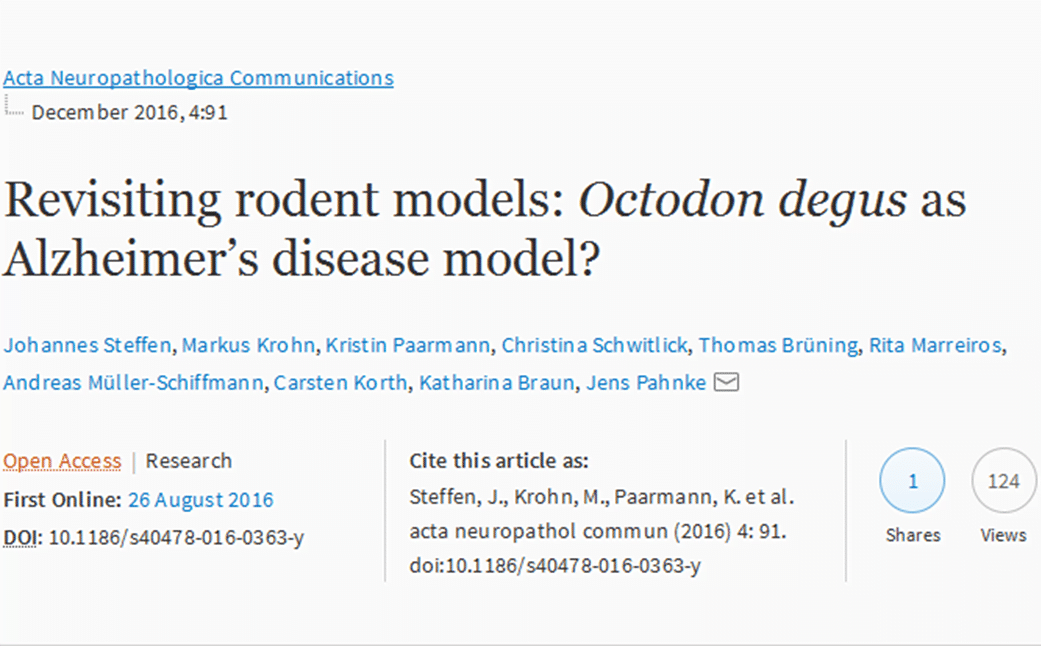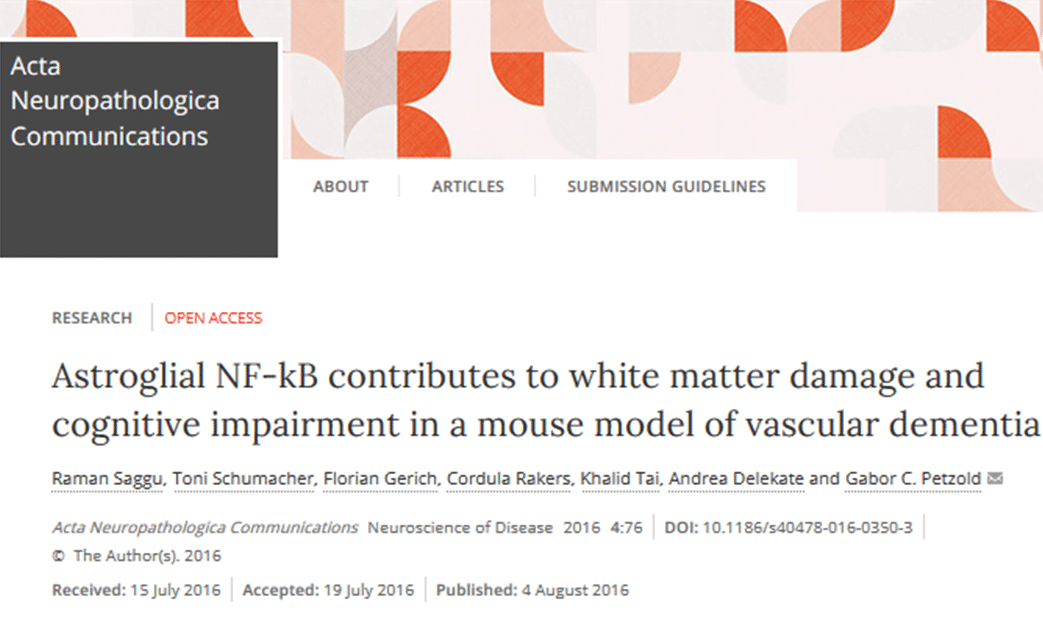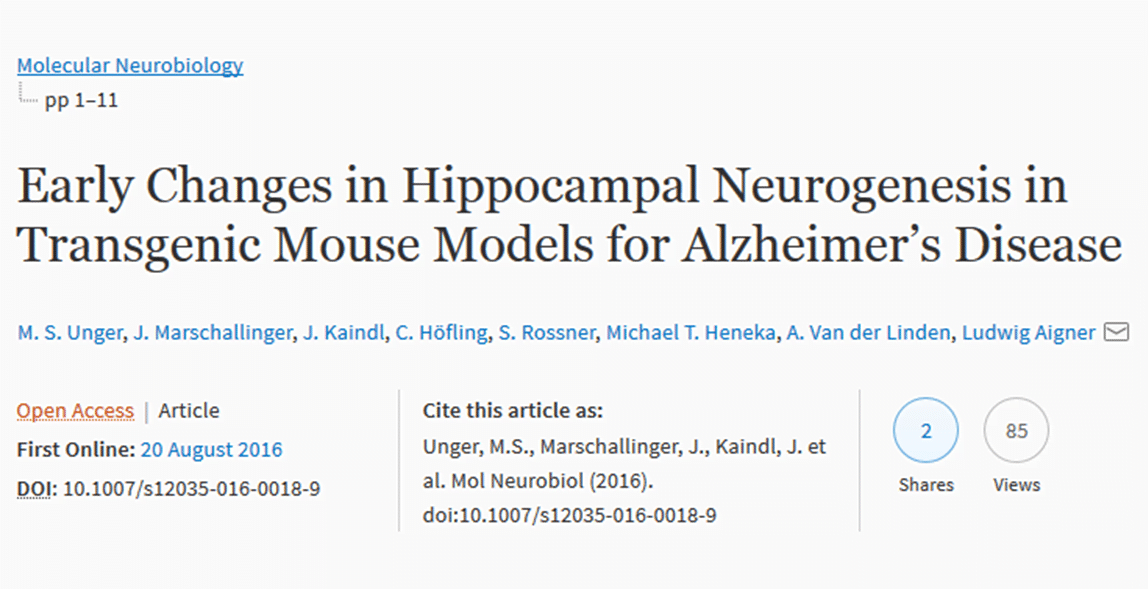 “Revisiting rodent models: Octodon degus as Alzheimer’s disease model?” has been published in Acta Neuropathologica Communications. This research was supported in part by JPND through the NeuroGem project, selected under the 2013 cross-disease analysis call, and the PROP-AD project, selected under the 2015 JPco-fuND call.
“Revisiting rodent models: Octodon degus as Alzheimer’s disease model?” has been published in Acta Neuropathologica Communications. This research was supported in part by JPND through the NeuroGem project, selected under the 2013 cross-disease analysis call, and the PROP-AD project, selected under the 2015 JPco-fuND call.
Tag Archives: animal models
A research project has shown that an experimental model of Alzheimer’s disease can be successfully treated with a commonly used anti-inflammatory drug.
Nearly everybody will at some point in their lives take non-steroidal anti-inflammatory drugs; mefenamic acid, a common Non-Steroidal Anti Inflammatory Drug (NSAID), is routinely used for period pain.
The findings are published in the journal Nature Communications.
Though this is the first time a drug has been shown to target this inflammatory pathway, highlighting its importance in the disease model, the researchers caution that more research is needed to identify its impact on humans, and the long-term implications of its use.
The research paves the way for human trials, which the team hope to conduct in the future.
In the study, transgenic mice that develop symptoms of Alzheimer’s disease were used. One group of 10 mice was treated with mefenamic acid, and 10 mice were treated in the same way with a placebo.
The mice were treated at a time when they had developed memory problems and the drug was given to them by a mini-pump implanted under the skin for one month.
Memory loss was completely reversed back to the levels seen in mice without the disease.
“These promising lab results identify a class of existing drugs that have potential to treat Alzheimer’s disease by blocking a particular part of the immune response,” said Dr. Doug Brown, Director of Research and Development at Alzheimer’s Society.
Paper: “Fenamate NSAIDs inhibit the NLRP3 inflammasome and protect against Alzheimer’s disease in rodent models”
Reprinted from materials provided by the University of Manchester.
 “Astroglial NF-kB contributes to white matter damage and cognitive impairment in a mouse model of vascular dementia” has been published in Acta Neuropathologica Communications. This research was supported in part by JPND through the DACAPO-AD project, selected under the 2015 JPco-fuND call.
“Astroglial NF-kB contributes to white matter damage and cognitive impairment in a mouse model of vascular dementia” has been published in Acta Neuropathologica Communications. This research was supported in part by JPND through the DACAPO-AD project, selected under the 2015 JPco-fuND call.
A new and versatile imaging technique enables researchers to trace the trajectories of whole nerve cells and provides extensive insights into the structure of neuronal networks.
Lesions caused by traumatic brain damage, stroke and functional decline due to aging processes can disrupt the complex cellular network that constitutes the central nervous system, and lead to chronic pathologies, such as dementia, epilepsy and deleterious metabolic perturbations. But exactly how this happens is unknown. Researchers have now refined a novel imaging technique that allows them to visualize and monitor these structural alterations in neuronal networks. The new findings appear in the journal Nature Methods.
Nerve cells transmit electrical impulses over long distances along fibrous connections called axons, which extend from the cell body where the nucleus resides. Indeed, many neurons in the brainstem possess axons that project as far as the base of the spinal column. Thus damage to these axons can affect the function of parts of the central nervous system that are remote from the actual site of injury. The new imaging method is based on a clearing-and-shrinkage procedure that can render whole organs and organisms transparent, making – for instance – the full length of the rodent spinal cord accessible to optical imaging. Moreover, the technique is applicable down to the level of individual cells, which are labeled with fluorescent protein tags and can be visualized under the microscope by irradiating them with visible light. This enables researchers to map complex neuronal networks in rodents in 3D, a significant step in revealing the enigma behind the human brain.
Because essentially all cell types – including immune cells and tumor cells – can be specifically labeled with the aid of appropriate fluorescent markers or antibodies, the new method can be employed in a broad range of biomedical settings. Furthermore, the images obtained can be archived in a database and made available to other researchers, which should help reduce unnecessary duplication of studies.
Paper: “Shrinkage-mediated imaging of entire organs and organisms using uDISCO”
Reprinted from materials provided by LMU Medical Center.
 “Early Changes in Hippocampal Neurogenesis in Transgenic Mouse Models for Alzheimer’s Disease” has been published in Molecular Neurobiology. This research was supported in part by the CrossSeeds project, selected for support in the 2013 cross-disease call.
“Early Changes in Hippocampal Neurogenesis in Transgenic Mouse Models for Alzheimer’s Disease” has been published in Molecular Neurobiology. This research was supported in part by the CrossSeeds project, selected for support in the 2013 cross-disease call.
 “Fibroblasts of Machado Joseph Disease patients reveal autophagy impairment” has been published in Scientific Reports. This research was supported in part by JPND through the ModelPolyQ project, selected for support under the 2015 JPco-fuND call, and the SynSpread project, selected for support under the 2013 cross-disease call.
“Fibroblasts of Machado Joseph Disease patients reveal autophagy impairment” has been published in Scientific Reports. This research was supported in part by JPND through the ModelPolyQ project, selected for support under the 2015 JPco-fuND call, and the SynSpread project, selected for support under the 2013 cross-disease call.
A new study provides additional evidence that amyloid-beta protein — which is deposited in the form of beta-amyloid plaques in the brains of patients with Alzheimer’s disease — is a normal part of the innate immune system, the body’s first-line defense against infection. The study, published in Science Translational Medicine, finds that expression of human amyloid-beta (A-beta) was protective against potentially lethal infections in mice, in roundworms and in cultured human brain cells. The findings may lead to potential new therapeutic strategies and suggest limitations to therapies designed to eliminate amyloid plaques from patient’s brains.
“Neurodegeneration in Alzheimer’s disease has been thought to be caused by the abnormal behavior of A-beta molecules, which are known to gather into tough fibril-like structures called amyloid plaques within patients’ brains,” says Robert Moir, MD, of the Genetics and Aging Research Unit in the Massachusetts General Hospital (MGH) Institute for Neurodegenerative Disease (MGH-MIND), co-corresponding author of the paper. “This widely held view has guided therapeutic strategies and drug development for more than 30 years, but our findings suggest that this view is incomplete.”
A 2010 study co-led by Moir and Rudolph Tanzi, PhD, director of the MGH-MIND Genetics and Aging unit and co-corresponding author of the current study, grew out of Moir’s observation that A-beta had many of the qualities of an antimicrobial peptide (AMP), a small innate immune system protein that defends against a wide range of pathogens. That study compared synthetic forms of A-beta with a known AMP called LL-37 and found that A-beta inhibited the growth of several important pathogens, sometimes as well or better than LL-37. A-beta from the brains of Alzheimer’s patients also suppressed the growth of cultured Candida yeast in that study, and subsequently other groups have documented synthetic A-beta’s action against influenza and herpes viruses.
The current study is the first to investigate the antimicrobial action of human A-beta in living models. The investigators first found that transgenic mice that express human A-beta survived significantly longer after the induction of Salmonella infection in their brains than did mice with no genetic alteration. Mice lacking the amyloid precursor protein died even more rapidly. Transgenic A-beta expression also appeared to protect C.elegans roundworms from either Candida or Salmonella infection. Similarly, human A-beta expression protected cultured neuronal cells from Candida. In fact, human A-beta expressed by living cells appears to be 1,000 times more potent against infection than does the synthetic A-beta used in previous studies.
That superiority appears to relate to properties of A-beta that have been considered part of Alzheimer’s disease pathology — the propensity of small molecules to combine into what are called oligomers and then aggregate into beta-amyloid plaques. While AMPs fight infection through several mechanisms, a fundamental process involves forming oligomers that bind to microbial surfaces and then clump together into aggregates that both prevent the pathogens from attaching to host cells and allow the AMPs to kill microbes by disrupting their cellular membranes. The synthetic A-beta preparations used in earlier studies did not include oligomers; but in the current study, oligomeric human A-beta not only showed an even stronger antimicrobial activity, its aggregation into the sorts of fibrils that form beta-amyloid plaques was seen to entrap microbes in both mouse and roundworm models.
Tanzi explains, “AMPs are known to play a role in the pathologies of a broad range of major and minor inflammatory disease; for example, LL-37, which has been our model for A-beta’s antimicrobial activities, has been implicated in several late-life diseases, including rheumatoid arthritis, lupus and atherosclerosis. The sort of dysregulation of AMP activity that can cause sustained inflammation in those conditions could contribute to the neurodegenerative actions of A-beta in Alzheimer’s disease.”
Moir adds, “Our findings raise the intriguing possibility that Alzheimer’s pathology may arise when the brain perceives itself to be under attack from invading pathogens, although further study will be required to determine whether or not a bona fide infection is involved. It does appear likely that the inflammatory pathways of the innate immune system could be potential treatment targets. If validated, our data also warrant the need for caution with therapies aimed at totally removing beta-amyloid plaques. Amyloid-based therapies aimed at dialing down but not wiping out beta-amyloid in the brain might be a better strategy.”
Says Tanzi, “While our data all involve experimental models, the important next step is to search for microbes in the brains of Alzheimer’s patients that may have triggered amyloid deposition as a protective response, later leading to nerve cell death and dementia. If we can identify the culprits — be they bacteria, viruses, or yeast — we may be able to therapeutically target them for primary prevention of the disease.”
Paper: “Amyloid-β peptide protects against microbial infection in mouse and worm models of Alzheimer’s disease”
Reprinted from materials provided by Massachusetts General Hospital.
While research has identified hundreds of genes required for normal memory formation, genes that suppress memory are of special interest because they offer insights into how the brain prioritizes and manages all of the information, including memories, that it takes in every day. These genes also provide clues for how scientists might develop new treatments for cognitive disorders such as Alzheimer’s disease.
Scientists have identified a unique memory suppressor gene in the brain cells of Drosophila, the common fruit fly, in a study published in the journal Neuron.
The researchers screened approximately 3,500 Drosophila genes and identified several dozen new memory suppressor genes that the brain has to help filter information and store only important parts. One of these suppressor genes, in particular, caught their attention.
“When we knocked out this gene, the flies had a better memory—a nearly two-fold better memory,” said Ron Davis, chair of the Department of Neuroscience at The Scripps Research Institute and leader of the study. “The fact that this gene is active in the same pathway as several cognitive enhancers currently used for the treatment of Alzheimer’s disease suggests it could be a potential new therapeutic target.”
When the scientists disabled this gene, known as DmSLC22A, flies’ memory of smells (the most widely studied form of memory in this model) was enhanced—while overexpression of the gene inhibited that same memory function.
“Memory processes and the genes that make the brain proteins required for memory are evolutionarily conserved between mammals and fruit flies,” said Research Associate Ze Liu, co-first author of the study. “The majority of human cognitive disease-causing genes have the same functional genetic counterparts in flies.”
The gene in question belongs to a family of “plasma membrane transporters,” which produce proteins that move molecules, large and small, across cell walls. In the case of DmSLC22A, the new study indicates that the gene makes a protein involved in moving neurotransmitter molecules from the synaptic space between neurons back into the neurons. When DmSLC22A functions normally, the protein removes the neurotransmitter acetylcholine from the synapse, helping to terminate the synaptic signal. When the protein is missing, more acetylcholine persists in the synapse, making the synaptic signal stronger and more persistent, leading to enhanced memory.
“DmSLC22A serves as a bottleneck in memory formation,” said Research Associate Yunchao Gai, the study’s other co-first author. “Considering the fact that plasma transporters are ideal pharmacological targets, drugs that inhibit this protein may provide a practical way to enhance memory in individuals with memory disorders.”
The next step, Davis added, is to develop a screen for inhibitors of this pathway that, independently or in concert with other treatments, may offer a more effective way to deal with the problems of memory loss due to Alzheimer’s and other neurodegenerative diseases.
“One of the major reasons for working with the fly initially is to identify brain proteins that may be suitable targets for the development of cognitive enhancers in humans,” said Davis. “Otherwise, we would be guessing in the dark as to which of the more than 23,000 human proteins might be appropriate targets.”
Source: Reprinted from materials provided by Eric Sauter at The Scripps Research Institute.
Researchers have shown how brain connections, or synapses, are lost early in Alzheimer’s disease and demonstrated that the process starts — and could potentially be halted — before telltale plaques accumulate in the brain. Their work, published online by Science, suggests new therapeutic targets to preserve cognitive function early in Alzheimer’s disease.
The researchers show in multiple Alzheimer’s mouse models that mechanisms similar to those used to “prune” excess synapses in the healthy developing brain are wrongly activated later in life. By blocking these mechanisms, they were able to reduce synapse loss in the mice.
Currently, there are five FDA-approved drugs for Alzheimer’s, but these only boost cognition temporarily and do not address the root causes of cognitive impairment in Alzheimer’s. Many newer drugs in the pipeline seek to eliminate amyloid plaque deposits or reduce inflammation in the brain, but the new research from Boston Children’s suggests that Alzheimer’s could be targeted much earlier, before these pathologic changes occur.
“Synapse loss is a strong correlate of cognitive decline,” says Beth Stevens, assistant professor in the Department of Neurology at Boston Children’s, senior investigator on the study and a recent recipient of the MacArthur “genius” grant. “We’re trying to go back to the very beginning and see how synapse loss starts.”
The researchers looked at Alzheimer’s — a disease of aging — through an unusual lens: normal brain development in infancy and childhood. Through years of research, the Stevens lab has shown that normal developing brains have a process to “prune” synapses that aren’t needed as they build their circuitry.
“Understanding a normal developmental process deeply has provided us with novel insight into how to protect synapses in Alzheimer’s and potentially a host of other diseases,” says Stevens, noting that synapse loss also occurs in frontotemporal dementia, Huntington’s disease, schizophrenia, glaucoma and other conditions.
In the Alzheimer’s mouse models, the team showed that synapse loss requires the activation of a protein called C1q, which “tags” synapses for elimination. Immune cells in the brain called microglia then “eat” the synapses — similar to what occurs during normal brain development. In the mice, C1q became more abundant around vulnerable synapses before amyloid plaque deposits could be observed.
When Stevens and colleagues blocked C1q, a downstream protein called C3, or the C3 receptor on microglia, synapse loss did not occur.
“Microglia and complement are already known to be involved in Alzheimer’s disease, but they have been largely regarded as a secondary event related to plaque-related neuroinflammation, a prominent feature in progressed stages of Alzheimer’s,” notes Soyon Hong, the Science paper’s first author. “Our study challenges this view and provides evidence that complement and microglia are involved much earlier in the disease process, when synapses are already vulnerable, and could potentially be targeted to preserve synaptic health.”
A human form of the antibody Stevens and Hong used to block C1q, known as ANX-005, is in early therapeutic development with Annexon Biosciences (San Francisco) and is being advanced into the clinic. The researchers believe it has potential to be used someday to protect against synapse loss in a variety of neurodegenerative diseases.
“One of the things this study highlights is the need to look for biomarkers for synapse loss and dysfunction,” says Hong. “As in cancer, if you treat people at a later stage of Alzheimer’s, it may already be too late.”
The researchers also found that the beta-amyloid protein, C1q and microglia work together to cause synapse loss in the early stages of Alzheimer’s. The oligomeric form of beta-amyloid (multiple units of beta-amyloid strung together) is already known to be toxic to synapses even before it forms plaque deposits, but the study showed that C1q is necessary for this effect. The converse was also true: microglia engulfed synapses only when oligomeric beta-amyloid was present.
Source: Reprinted from materials provided by Boston Children’s Hospital
Paper: “Complement and microglia mediate early synapse loss in Alzheimer mouse models”
A new study in the journal Nature Communications shows that cells normally associated with protecting the brain from infection and injury also play an important role in rewiring the connections between nerve cells. While this discovery sheds new light on the mechanics of neuroplasticity, it could also help explain diseases like autism spectrum disorders, schizophrenia, and dementia, which may arise when this process breaks down and connections between brain cells are not formed or removed correctly.
While the constant reorganization of neural networks – called neuroplasticity – has been well understood for some time, the basic mechanisms by which connections between brain cells are made and broken have eluded scientists.
Performing experiments in mice, the researchers employed a well-established model of measuring neuroplasticity by observing how cells reorganize their connections when visual information received by the brain is reduced from two eyes to one.
The researchers found that in the mice’s brains microglia responded rapidly to changes in neuronal activity as the brain adapted to processing information from only one eye. They observed that the microglia targeted the synaptic cleft – the business end of the connection that transmits signals between neurons. The microglia “pulled up” the appropriate connections, physically disconnecting one neuron from another, while leaving other important connections intact.
The researchers also pinpointed one of the key molecular mechanisms in this process and observed that when a single receptor – called P2Y12 – was turned off the microglia ceased removing the connections between neurons.
These findings may provide new insight into disorders that are the characterized by sensory or cognitive dysfunction, such as autism spectrum disorders, schizophrenia, and dementia. It is possible that when the microglia’s synapse pruning function is interrupted or when the cells mistakenly remove the wrong connections – perhaps due to genetic factors or because the cells are too occupied elsewhere fighting an infection or injury – the result is impaired signaling between brain cells.
Source: University of Rochester Medical Center (URMC)
